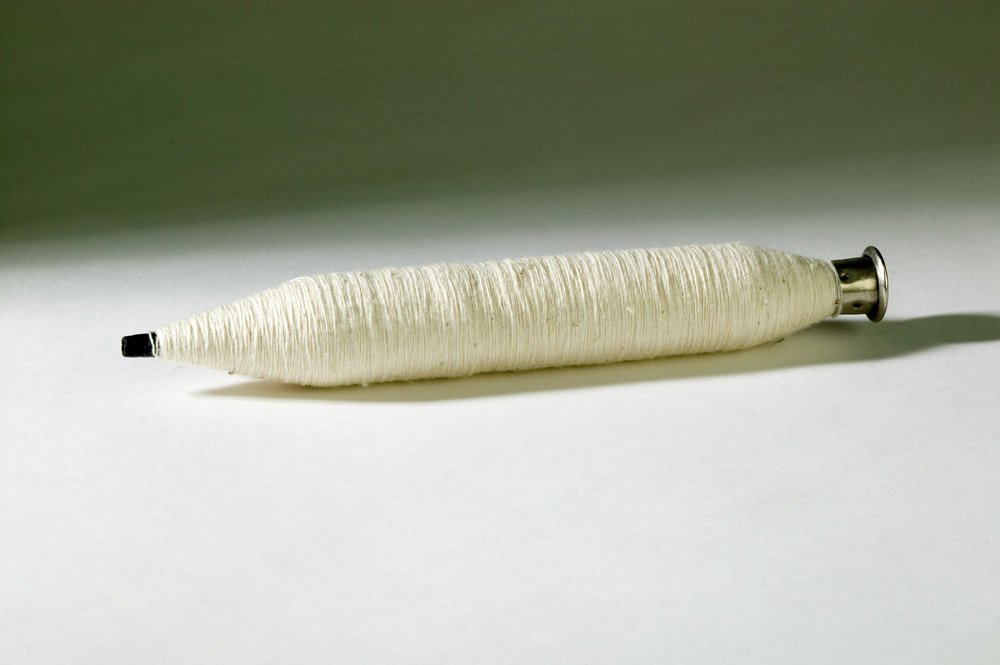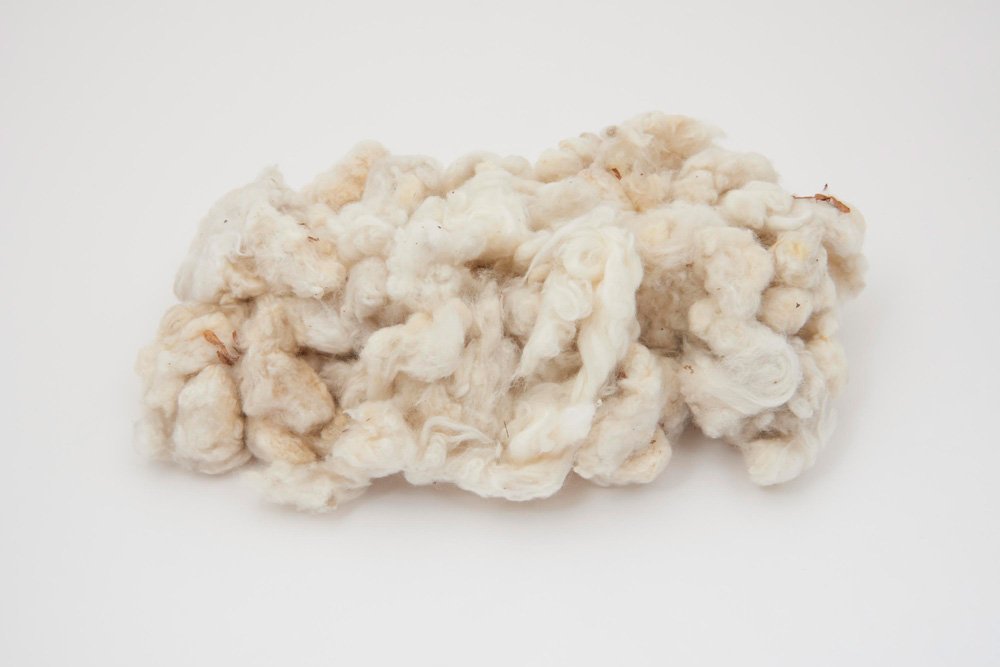How Did The Water Frame Impact The Industrial Revolution
Discover how Richard Arkwright kick-started a transformation in the textiles industry and created a vision of the machine-powered, factory-based future of manufacturing.
Since the early on 18th century, manufacturers had been looking for inventive ways to meet the always-growing demand for cotton material and yarn. Finally, in 1767, a breakthrough came when a Lancashire entrepreneur, Richard Arkwright (1732–92), devised a elementary but remarkable spinning machine. Replacing the work of homo hands, the water frame made it possible to spin cotton yarn more than rapidly and in greater quantities than ever earlier.
Craze for cotton
Cotton cloth has been made around the world for thousands of years. Merchants commencement brought it to Britain from India around 500 years agone. Information technology was lighter, brighter and could be washed and dried more easily than the heavy, woollen fabrics that people in U.k. were used to. It was as well a valuable trading article, with merchants exchanging cloth for appurtenances across the world.
The craze for cotton fiber drove entrepreneurial makers in Britain to search for ways to run into the ascension demand. Some began experimenting with the evolution of spinning machines, which they hoped would speed upwardly the production of cotton wool yarn by taking over the tedious work washed by human being hands using spinning wheels.
What is spinning?
When cotton wool is picked from the plant information technology grows on, the weak fibres break and pull apart hands. To make cotton fiber strong plenty to be woven into cloth, information technology first needs to be spun. Spinning is the process of twisting together drawn-out fibres of cotton into a strong, unmarried strand, called yarn.
 Science Museum Group Collection
Science Museum Group Collection
 Science Museum Group Drove
Science Museum Group Drove
Despite ambitious attempts, including the roller spinning machine devised past Lewis Paul and John Wyatt in 1738, none succeeded in developing a reliable and efficient machine able to spin yarn of the desired quality.
At the aforementioned time, Richard Arkwright, a determined Lancashire businessperson who realised the turn a profit-making potential of cotton spinning, had been keeping a close centre on their efforts and their mistakes.
Arkwright's breakthrough
Arkwright was born in 1732 in Preston to a poor family, and had already developed a successful hair-cutting and wig-making business in Bolton by the time he became interested in cotton fiber spinning.
In 1767, he met John Kay, a skilled clockmaker with the technical power needed to build machines. With Kay, Arkwright developed his first image spinning car. Initially designed to be driven by horsepower, the machine'due south moving rollers drew out the cotton fibres, imitating the activeness of a manus spinner's fingers. Then, its rotating spindles twisted the cotton fiber into yarn and wound it onto a bobbin.
 Scientific discipline Museum Group Collection
Scientific discipline Museum Group Collection
Although other makers had also been working on spinning machines using a similar principle, Arkwright made crucial developments that gear up his machine apart, succeeding where others had failed. After months of experimentation and aligning, he discovered the correct spacing for the rollers that drew out the cotton fibre, and hung weights from the pinnacle fix of rollers so they could grip the bottom rollers firmly.
Nevertheless, challenges to the originality of Arkwright's designs plagued him throughout his life (encounter 'Arkwright on trial' below).
Creating a factory system
Granted a patent in 1769 for his auto, Arkwright and his business partners were determined to make money from the invention. They built a huge, multi-storey factory in Cromford, Derbyshire, alongside the fast-flowing River Derwent.
 Science Museum Group Collection
Science Museum Group Collection
Arkwright had realised that waterpower, rather than horsepower, was the most efficient way to run his machines. Huge waterwheels installed at the manufactory, driven by the river, provided the rotary move to bulldoze the machinery. Thereafter, Arkwright's spinning machines became known as h2o frames.
The ingenious design of the water frame meant the machines could be operated past unskilled workers. As long equally they kept them fed with cotton, pieced up any breakages in the yarn and changed total bobbins for empty ones, the h2o frames could churn out huge quantities of potent and even yarn, which weavers needed to produce cotton cloth.
Arkwright had turned a mechanical principle into a consistently productive, industrial machine.
The Cromford mill expanded apace and Arkwright built further mills across Derbyshire and Lancashire. He continued to innovate—for example, his Manchester mill on Miller Street was the start spinning mill to make utilize of steam power.
Arkwright as well fabricated connections in Scotland, expanding his spinning operations northward of the border. He amassed a huge fortune from his cotton spinning empire by selling the yarn produced in his mills and licensing his machinery to other manufacturers.
Arkwright on trial
Richard Arkwright was a ruthless businessperson. In 1781, he took legal activeness again nine Manchester spinning firms who were using his inventions without license. The Manchester manufacturers argued that they should have the freedom to use the mechanism as they wished.
In response to Arkwright'due south challenges, manufacturers called into question the validity of Arkwright's patents, arguing that they did not demonstrate the originality of his inventions. A series of courtroom cases followed, culminating in the patent trial of June 1785, where Arkwright was defendant of copying the spinning invention of a automobile maker called Thomas Highs. Highs told the court that the rollers used on Arkwright'south water frame had been devised by him. Arkwright's carding engine patent was also challenged.
The court brought a verdict against Arkwright, cancelling both of his patents, much to the satisfaction of cotton fiber manufacturers who from and then on, were costless to employ his inventions without restriction.
Working lives transformed
By 1800, almost 1,000 men, women and children were employed in Arkwright's mills and thousands of others worked in factories set by other profit-seeking entrepreneurs. Working lives were transformed. Instead of spinning at home, people at present worked long, repetitive and exhausting days in huge, multi-storey mills, looking subsequently the machines. In the primeval days of Arkwright's mills, product went on around the clock, with two 13-hour shifts per day.
The profits arising from the machinery of Sir Richard Arkwright were and then considerable, that it frequently happened… that the machinery was employed for the whole four-and-twenty hours.
Sir Robert Peel (1816)
Working a gear up number of hours to the pace of the factory's mechanism was a completely new manner of life. High temperatures and dust levels in the factories compounded the demanding hours of labour and monotony of the work. Working amongst the roaring machines without protection, many workers also experienced hearing loss. There were no effective laws to regulate mill work and look after the rubber of workers until well into the 19th century.
Arkwright patented a carding engine in 1774. Carding is the process of combing out the cotton fiber fibres, set up to be spun. Once Arkwright's h2o frames increased the amount of cotton that could be spun, manufacturers too needed powered machines to become plenty cotton ready for spinning.
Arkwright'due south legacy
By transferring cotton spinning from the home to huge, powered mills filled with hundreds of workers, Arkwright showed it was possible to ready a purpose-built factory, install a power source, equip information technology with machinery, hire a workforce and make a turn a profit.
Other mill owners modelled their mills on Arkwright's case. Although his h2o frame was ultimately replaced by a more advanced spinning car, the mule, adult in 1775 by Samuel Crompton, Arkwright transformed the cotton manufacture and made a meaning contribution to the growth of the factory system of production which we recognise today.
Related objects in our collection
Suggestions for further research
- RS Fitton, The Arkwrights: Spinners of Fortune(Manchester: Manchester University Press, 1989)
- R Osborne, Atomic number 26, Steam and Money: The Making of the Industrial Revolution (London: Random Business firm, 2013)
- K Dibbits,Richard Arkwright: innovation and controversy, Scientific discipline and Industry Museum blog, 3 Baronial 2017
- Discover more: Arkwright's water frame, Science and Industry Museum YouTube channel, fourteen December 2017
How Did The Water Frame Impact The Industrial Revolution,
Source: https://www.scienceandindustrymuseum.org.uk/objects-and-stories/richard-arkwright
Posted by: wrightsagessay.blogspot.com



0 Response to "How Did The Water Frame Impact The Industrial Revolution"
Post a Comment